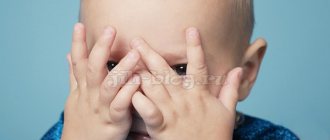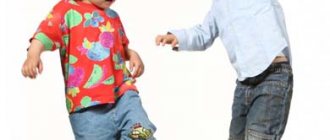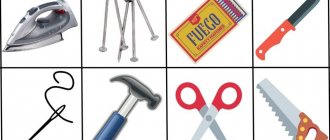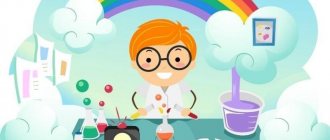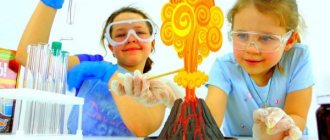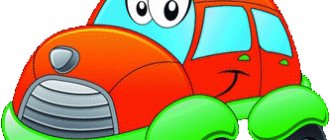Finger gymnastics “Pets” in the senior group
We offer finger games that will introduce older preschoolers to what animals and birds live with humans.
Sheep
What kind of animals have fur in rings? - children connect their index and thumb, making the “Ok” sign;
These are sheep wandering in the pasture.
They are guarded by the shaggy Barbos - they depict a dog with a brush, bend the index finger, stick out the thumb, move the little finger, imitating how a dog barks;
His black nose senses where the wolves are.
And the shepherd boy on the hill near the aspen tree - they raise their arms above their heads, imitating a hill, then swing their raised arms from side to side, imitating a tree;
The song is played beautifully on the pipe. - imitate playing the pipe, fingering the air;
The sheep and the dog are listening to the song,
Listen to poppies, daisies, oats. - join the wrists, spread the fingers, imitating flowers;
And the bell nods its head, and swings its tassels in different directions;
It’s as if he’s singing along to a song. - put your palm to the shell of your ear, as if listening.
Chickens
Two pied hens hatched their chicks; the pupils clenched their fists and extended their thumbs, imitating chicken beaks;
Those chicks followed their mothers in a row. - bend and straighten your fingers at a pace;
Behind each pestle there are four chickens,
Four cheerful and colorful children. - alternately connect the right fingers, starting with the little finger, ending with the index finger, with similar left fingers;
Chickens fight, play, squeak,
They flap their wings and eat grains. - clasping hands, moving fingers chaotically;
As soon as the sun hides, the chicks go home, clenching their fists;
They lie down to rest under mommy’s wing. - put your palms together and place them under your cheek, pretending to be asleep.
Piglets
Oh-la-la, oh-la-la, a family of pigs! - children clench their fists;
The first piglet wags its tail, and the little finger is extended;
The second pig wipes its side against the wall, the nameless one is unbent;
The third little pig is picking around the beds; the middle one is being straightened out;
The fourth little pig is bathing in a puddle; the index finger is extended;
The fifth little pig is a bully and impudent one; they straighten their thumb;
To sleep in the middle, he pushed his brothers apart. - clench and unclench your fists at a pace.
Goby
You can hear the hooves - clop-clop-clop!
A bull runs towards the boy. - students tap on a hard surface with their fingertips.
puts out his horns,
He wants to fight. - straighten the little finger and index finger on both hands, rotate the hands;
But the boy is not afraid,
The boy is brave, - with one hand they stroke the other;
He'll bring a little water,
And he will take you to the lawn. - clasp their hands in a “lock”.
Finger gymnastics complexes for children of the senior group of preschool educational institutions
Knead vigorously. (make massaging movements)
.
Finger gymnastics “For the berries”
Goal : develop fine motor skills and coordination of movements.
One, two, three, four, ( fingers of both hands “hello”
.)
Let's go for a walk in the forest, ( fingers
"walking.")
For blueberries, (bend one finger .)
For raspberries
For lingonberries,
Behind the viburnum.
We'll find strawberries
We'll bring it to my brother too.
Finger gymnastics “We drew”
Goal : develop fine motor skills and coordination of movements.
Today we drew (children raise their hands in front of them.)
Our fingers are tired
.
our fingers
,
(shakes their brushes.)
Let’s start painting again.
Finger gymnastics “My hands are missing”
Goal : develop fine motor skills and coordination of movements.
My hands are gone (we hide our hands behind our back)
Maybe they're bored
Did you run away to the zoo?
No, my fugitives have been found, (we show our hands.)
They and the jam were in a jar.
My pens are just a treasure.
Finger gymnastics “ Fingers went for a walk ”
Goal : develop fine motor skills and coordination of movements.
One, two, three, four, five (we alternately extend our fingers from our fists
, starting with the
thumb
.)
Fingers went out
,
One, two, three, four, five (we alternately bend our fingers
into fists starting with the little finger.)
They hid in the house again.
Finger gymnastics “On the meadow”
Goal : develop fine motor skills and coordination of movements.
( Finger
into the fist in the rhythm of a nursery rhyme.
When listing animals, bend the fingers
on both hands alternately.)
Bunnies came to the meadow,
Bear cubs, badgers,
Frogs and raccoon.
Come too, my friend!
Finger gymnastics “Beehive”
Goal : develop fine motor skills and coordination of movements.
( Clench your fingers into a fist . Then bend them one at a time.)
Here is a small hive where the bees are
They hid, no one would see them.
Here they appeared from the hive.
One, two, three, four, five!
Finger gymnastics “We need to sleep”
Goal : develop fine motor skills and coordination of movements.
Who didn't go to bed? (Hands pressed palms together. Lie on the back of one of the hands on the table, knees).
Who doesn't want to sleep? (Turn your hands over to the other “side”
.)
So disobedient
I'll tickle! (We tickle one palm and then the other with our fingers.)
Finger gymnastics “Fish”
Goal : develop fine motor skills and coordination of movements.
The fish are frolicking merrily
In clean, warm water.
They will shrink, they will unclench,
They will bury themselves in the sand.
(Imitate the movements of fish with your hands in accordance with the text)
.
Finger gymnastics “I have toys”
Goal : develop fine motor skills and coordination of movements.
I have toys: (Clap their hands and hit their fists alternately.)
Preparatory group
We offer finger games to expand understanding of the world around us and improve motor skills in older preschoolers.
Goat
One day an old goat - the pupils put their index finger and little finger to their forehead;
I found a treat in the garden beds. - walk with fingers on a horizontal surface;
He looks around - he turns his head left and right;
Deliciousness here and there:
The grass spreads below, they lower their heads;
Lush foliage at the top. - raise their head;
Here's a cabbage, here's a carrot, they squat down;
Here’s a curly bean,” they raise their hands, stretching them upward on their tiptoes;
Behind there is a bed of tomatoes, they turn 180°;
There are flowers in a row in front, they turn back;
On the left - onions and cucumbers - turn 90° with the body to the left;
On the right are currant bushes, turning 90° to the right;
There are a hundred berries on them, no - two hundred. - tilt the body left and right;
The goat is marking time. - rotate around its axis;
Our goat thought for a long time,
Until the owner came. — they walk in place.
Methodological development “Finger games card index” for children of the first junior group
Annotation:
The methodological development is a card index of finger games used with children of the first junior group. Finger gymnastics can be used in work at different periods of time: during routine moments, in the morning and evening, as well as during a walk. The methodological development is designed for children from 2 to 3 years old and can be useful for educators and parents in general academic year.
Target:
develop fine motor skills of the hands to develop the speech of children of the first junior group in the process of finger games.
Tasks:
Educational:
-develop the ability to imitate the movements of the teacher’s hands;
-establish contacts and emotional communication between teacher and child;
-combine games and exercises to develop finger motor skills with speech;
Educational:
-develop attention, visual perception, speech;
Educational:
- to cultivate a love for small folklore genres and Russian folk tales.
Relevance:
Due to their age, children's mastery of gross and fine motor skills of their fingers presents some difficulties. Imperfect development of fine motor skills of the fingers causes difficulties in teaching self-service skills, in subject-related practical activities, and fine art activities (drawing, modeling, design).
But finger games with simple movements and cheerful poetic accompaniment are liked and evoke a positive emotional response. The variety of tasks, their problematic nature and playful orientation, make it possible to increase interest in learning more complex exercises and contribute to better orientation in everyday life. Therefore, it is recommended to use finger exercises before conducting practical activities to teach self-service or game-activities in kindergarten.
Main part:
Stages of learning games:
1. The teacher first demonstrates the game with fingers himself.
2. Ped a
Gog demonstrates the game by manipulating the student's fingers and hand.
3. The teacher and student perform the movements simultaneously, the teacher pronounces the text.
4. The child performs the movements with the necessary help of the teacher, who pronounces the text.
5. The child performs the movements independently, the text is pronounced together.
To carry out this work it is necessary to use various
methods and techniques:
a visual method of work - showing how fingers should move when performing finger gymnastics;
verbal method of work - reciting nursery rhymes and poems when performing finger gymnastics; memorizing poems and nursery rhymes;
The practical method of work is finger play.
Conclusion:
An important part of the work on developing fine motor skills is “finger games”. These games are very emotional and exciting. They promote the development of speech and creative activity. “Finger games” seem to reflect the reality of the surrounding world - objects, animals, people, their activities, natural phenomena. During “finger games,” children, repeating the movements of adults, activate hand motor skills. This develops dexterity, the ability to control one’s movements, and concentrate attention on one type of activity.
Finger games give parents and educators the opportunity to play with their children, delight them and, at the same time, develop speech and fine motor skills; the child receives a variety of sensory impressions, and develops attentiveness and the ability to concentrate. Such games form good relationships between children, as well as between adults and children.
Bibliography:
Agranovich 3. E. “Collection of homework to help speech therapists and parents to overcome lexical and grammatical underdevelopment of speech in preschoolers with OHP” - St. Petersburg. "Childhood-Press", 2005
Bodrachenko I.V. “Game leisure activities for children” Library of the magazine “Preschool Educator”. Creative, M. 2011
Krupenchuk O.I. “Teach me to speak correctly! A manual on speech therapy for children and parents.” - St. Petersburg. Publishing House "Litera", 2003
Nishcheva N.V. “Card index of outdoor games, exercises, physical exercises, finger gymnastics.” St. Petersburg LLC Publishing House "Childhood-Press", 2010
Nishcheva N.V. “The system of correctional work in a speech therapy group for children with general speech underdevelopment” St. Petersburg. CHILDHOOD - PRESS, 2003
Savina L. P. “Finger gymnastics for the development of speech of preschoolers: A manual for parents and teachers” M.: AST Publishing House LLC, 2001
Timonen E. I., Tuyulainen E. T. “Continuous system for correction of general speech underdevelopment in a special kindergarten group for children with severe speech impairments (senior group)” Petrozavodsk: Peter GU Publishing House, 1999
Uzorova O. V., Nefedova E. A. “Finger games”
- M.: AST Publishing House, 2004
9. Ya.L. Yudina, Zakharova I. S. “Collection of speech therapy exercises”
M.: VAKO, 2010

